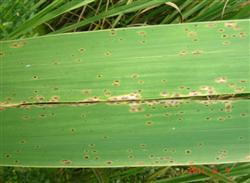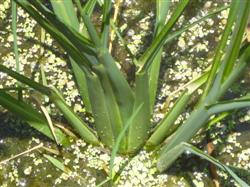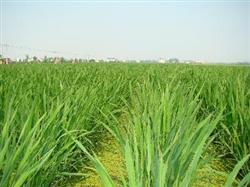High temperature and high humidity Zizania latifolia is prone to flax leaf spot.

Leaf spot of Zizania caduciflax is a fungal disease. In recent years, with the increasing area of Zizania caduciflora, the scope of the disease has gradually expanded, and the disease is becoming more and more serious. The disease can occur in the whole growing period of Zizania caduciflora. The main harm to the leaves, the early leaves appeared yellow-brown spots, and then expanded into sesame-sized brown spots, a few into strips, the disease spot is often surrounded by a yellow halo, the late spot edge is dark brown, the middle is yellow-brown or gray-white. In severe cases, the disease spots are densely covered, and some of them are connected into irregular spots, and when the humidity is high, the disease spots are dark gray to black mildew. The disease spot is smaller when the plant is nitrogen deficient, larger when potassium deficiency, and has obvious wheel pattern. When the disease spot is long, a large necrotic area is formed on the leaf, which makes the leaf gradually dry up from the leaf tip to the bottom, and often causes the leaf to die in the later stage. The disease overwinters mainly in mycelium and conidia on the remains of the disease. Bacteria infecting Zizania caduciflora not only requires more than 92% relative humidity, but also requires water droplets. The upper onset period of Zizania latifolia in autumn is from late June to early July, the disease occurs quickly around July 10, the peak occurs from July 20 to early September, the disease slows down after the middle of September, and stops developing in the middle of November. The soil is sour, lack of potassium or zinc, long-term irrigation of deep water hypoxia, extensive management of the field disease is serious. Under the condition of high temperature and high humidity, the continuous cropping field has high planting density, partial application of nitrogen fertilizer, poor ventilation and light transmission in the field, which is easy to induce the disease. In order to prevent the leaf spot of Zizania latifolia and flax, attention should be paid to strengthening field management. (1) rotation. Rotate Zizania caduciflora with lotus root, water chestnut, Cigu, taro and so on. (2) cutting stubble. In winter, the plants of Zizania caduciflora were cut at a height of 1.5 cm above the ground, and the leaves of the residual plants were taken out of the field and burned. (3) fertilization. Wax fertilizer is applied in winter, seedling fertilizer is applied in spring, and foliar fertilizer is sprayed in time. Mainly organic fertilizer, usually 2500-4000 kg per mu. If there is a lack of phosphorus and potassium, pay attention to supplement phosphorus and potassium fertilizer and zinc fertilizer. (4) Pipe water. During the high temperature period from July to August, the water layer is kept at 12-18 cm, and the water is often changed to cool down. Pay attention to shelving the field, after each cultivation until the topsoil is cracked and then irrigated, in order to improve the root activity of Zizania caduciflora. In production, the drug should be used to control the leaf spot of Zizania caduciflora from the late tillering stage or in the early stage of the disease. spray with 1500-2000 times of 25% prochloraz EC, or 1000 times of 50% isobarbazide wettable powder, or 5000-6000 times of Fuxing 40% flusilazole EC, once every 10 days, for 2-3 times continuously.
- Prev

Causes and prevention of male transformation of Zizania caduciflora
In the process of planting Zizania latifolia, there are often plants with flowering stems but not Zizania caduciflora, which are called "male Zizania latifolia" or "strong Zizania latifolia". Zizania caduciflora lost the ability of bolting, flowering and fruiting after being infected with smut fungus, and the flower stem expanded to form Zizania caduciflora. The spread of smut was mainly caused by the previous year.
- Next

Occurrence characteristics and integrated control of diseases and insect pests in alpine Zizania caduciflora
The key points of off-season cultivation techniques of low-altitude double-season Zizania caduciflora are introduced as follows: first, select the improved varieties of Zizania latifolia (belonging to single-season Zizania latifolia). Second, the field with loose and fertile soil should be used as seedling field. At the end of the first ten days of November, the signs will be dried up to 6mur7, 1.
Related
- Where is it suitable to grow horseradish in China? it is expected to see the middle altitude horseradish in Alishan.
- How to prevent tomato virus disease reasonably? (Control methods included)
- Many people like to plant towel gourd on the balcony. What are the main points of this method and management?
- What crops can chili peppers be mixed with?
- Fertilization techniques and matters needing attention in Tomato
- What are the grafting techniques for peach seedlings in spring?
- Harm and control methods of root swelling disease of Chinese cabbage
- What are the pests of sweet potatoes? How to prevent and cure it?
- Symptoms, causes and Control methods of navel Rot in Tomato
- The cause of "Cucumber rotten bibcock" in Farmers' planting Cucumber and its Control Plan

